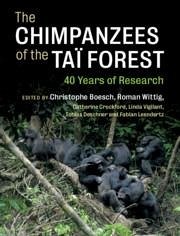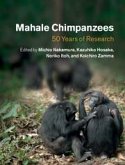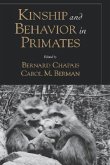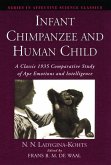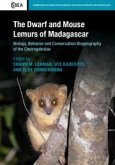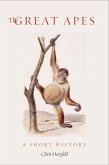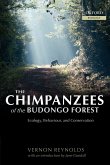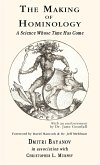The Chimpanzees of the Taï Forest
40 Years of Research
Herausgeber: Boesch, Christophe; Wittig, Roman
The Chimpanzees of the Taï Forest
40 Years of Research
Herausgeber: Boesch, Christophe; Wittig, Roman
- Gebundenes Buch
- Merkliste
- Auf die Merkliste
- Bewerten Bewerten
- Teilen
- Produkt teilen
- Produkterinnerung
- Produkterinnerung
An engaging account of the research and key findings on Taï chimpanzees to celebrate the 40th anniversary of this project.
Andere Kunden interessierten sich auch für
![Mahale Chimpanzees Mahale Chimpanzees]() Mahale Chimpanzees215,99 €
Mahale Chimpanzees215,99 €![Kinship and Behavior in Primates Kinship and Behavior in Primates]() Bernard ChapaisKinship and Behavior in Primates130,99 €
Bernard ChapaisKinship and Behavior in Primates130,99 €![Infant Chimpanzee and Human Child Infant Chimpanzee and Human Child]() N N Ladygina-KohtsInfant Chimpanzee and Human Child115,99 €
N N Ladygina-KohtsInfant Chimpanzee and Human Child115,99 €![The Dwarf and Mouse Lemurs of Madagascar The Dwarf and Mouse Lemurs of Madagascar]() The Dwarf and Mouse Lemurs of Madagascar125,99 €
The Dwarf and Mouse Lemurs of Madagascar125,99 €![The Great Apes The Great Apes]() Chris HerzfeldThe Great Apes27,99 €
Chris HerzfeldThe Great Apes27,99 €![The Chimpanzees of the Budongo Forest The Chimpanzees of the Budongo Forest]() Vernon ReynoldsThe Chimpanzees of the Budongo Forest113,99 €
Vernon ReynoldsThe Chimpanzees of the Budongo Forest113,99 €![The Making of Hominology The Making of Hominology]() Dmitri BayanovThe Making of Hominology38,99 €
Dmitri BayanovThe Making of Hominology38,99 €-
-
-
An engaging account of the research and key findings on Taï chimpanzees to celebrate the 40th anniversary of this project.
Hinweis: Dieser Artikel kann nur an eine deutsche Lieferadresse ausgeliefert werden.
Hinweis: Dieser Artikel kann nur an eine deutsche Lieferadresse ausgeliefert werden.
Produktdetails
- Produktdetails
- Verlag: Cambridge University Press
- Seitenzahl: 516
- Erscheinungstermin: 2. Januar 2020
- Englisch
- Abmessung: 254mm x 192mm x 27mm
- Gewicht: 1179g
- ISBN-13: 9781108481557
- ISBN-10: 1108481558
- Artikelnr.: 56714078
- Herstellerkennzeichnung
- Libri GmbH
- Europaallee 1
- 36244 Bad Hersfeld
- gpsr@libri.de
- Verlag: Cambridge University Press
- Seitenzahl: 516
- Erscheinungstermin: 2. Januar 2020
- Englisch
- Abmessung: 254mm x 192mm x 27mm
- Gewicht: 1179g
- ISBN-13: 9781108481557
- ISBN-10: 1108481558
- Artikelnr.: 56714078
- Herstellerkennzeichnung
- Libri GmbH
- Europaallee 1
- 36244 Bad Hersfeld
- gpsr@libri.de
Introduction; 1. War and peace in the Taï Chimpanzee Project: running a
long-term Chimpanzee research project Christophe Boesch; 2. Developments in
statistical methods applied over four decades of research, Taï Chimpanzee
Project Roger Mundry; 3. Observation protocol and long-term data collection
in Taï Roman Wittig and Christophe Boesch; 4. The Wild Chimpanzee
Foundation (WCF) and the Taï Chimpanzee Project (TCP) Emmanuelle Normand,
Ilka Herbinger, Joseph Kouassi and Yves A. Kablan; 5. Insights from genetic
analyses of the Taï chimpanzees Linda Vigilant; 6. Endocrinological
analyses at Taï Tobias Deschner and Verena Behringer; 7. Chimpanzee
behavioural diversity and the contribution of the Taï Chimpanzee Project
Christophe Boesch; 8. An energetic model of foraging optimisation: wild
chimpanzee hammer selection for nut-cracking Giulia Sirianni, Lydia Luncz
and Paolo Gratton; 9. Demography and life history of five chimpanzee
communities in Taï National Park Christophe Boesch and Roman Wittig; 10.
Adoption in the Taï chimpanzees: costs, benefits, and strong social
relationships Liran Samuni, Roman Wittig and Catherine Crockford; 11.
Spatial integration of unusually high numbers of immigrant females into the
South Group: further support for the bisexually-bonded model in Taï
chimpanzees Sylvain Lemoine, Catherine Crockford and Roman Wittig; 12.
Forty years striving to capture culture among the Taï chimpanzees
Christophe Boesch; 13. Cultural diversity of nut-cracking behaviour between
two populations of wild chimpanzees (pan troglodytes verus) in the Côte
d'Ivoire Lydia Luncz, Roger Mundry, Serge Soiret and Christophe Boesch; 14.
Ecological and social influences on rates of social play in immature wild
chimpanzees (pan troglodytes verus) Yasmin Moebius, Peter Walsh, Grégoire
Kohou and Christophe Boesch; 15. Long-term diet of the chimpanzees (pan
troglodytes verus) in Taï National Park: inter-annual variations in
consumption Zoro Bertin Gone Bi and Roman Wittig; 16. Why Taï Mangabeys do
not use tools to crack nuts like sympatric-living chimpanzees: a cognitive
limitation on monkey feeding ecology Karline Janmaat and Richard Byrn; 17.
Providing research for conservation from long-term field sites Marie-Lyne
Després-Einspenner, Yves A. Kablan, Celestin Kouakou, Hjalmar Kühl and Paul
N'Goran; 18. Rank changes in female chimpanzees in Taï National Park
Alexander Mielke, Catherine Crockford and Roman Wittig; 19. Effects of
large-scale knockouts on chimpanzee association networks Julia Riedel,
Christophe Boesch and Mathias Franz; 20. Why do the chimpanzees of the Taï
Forest share meat? The value of bartering, begging, and hunting Cristina
Gomes, Roger Mundry and Christophe Boesch; 21. Group specific social
dynamics affect urinary oxytocin levels in Taï male chimpanzees Anna Preis,
Liran Samuni, Tobias Deschner, Catherine Crockford and Roman Wittig; 22.
The chimpanzees of the Taï Forest as models for hominine microorganism
ecology and evolution Jan Gogarten, Grit Schubert, Fabian Leendertz and
Sébastien Calvignac-Spencer; 23. Acute infectious diseases occurring in the
Taï chimpanzee population: a review Livia Victoria Patrono and Fabian
Leendertz; 24. Why does the chimpanzee vocal repertoire remain poorly
understood? And what can be done about it Catherine Crockford; 25. Sexual
dimorphism in chimpanzee vocalisations: a comparison of male and female
call production and acoustic parameters Ammie Kalan; 26. Gestural usage and
development in two subspecies of wild chimpanzees (pan troglodytes
Schweinfurthii/Verus) Marlen Fröhlich and Simone Pika; 27. Spatial
cognitive abilities in foraging chimpanzees Simone Ban and Emmanuelle
Normand; 28. Temporal cognition in Taï chimpanzees Karline Janmaat.
long-term Chimpanzee research project Christophe Boesch; 2. Developments in
statistical methods applied over four decades of research, Taï Chimpanzee
Project Roger Mundry; 3. Observation protocol and long-term data collection
in Taï Roman Wittig and Christophe Boesch; 4. The Wild Chimpanzee
Foundation (WCF) and the Taï Chimpanzee Project (TCP) Emmanuelle Normand,
Ilka Herbinger, Joseph Kouassi and Yves A. Kablan; 5. Insights from genetic
analyses of the Taï chimpanzees Linda Vigilant; 6. Endocrinological
analyses at Taï Tobias Deschner and Verena Behringer; 7. Chimpanzee
behavioural diversity and the contribution of the Taï Chimpanzee Project
Christophe Boesch; 8. An energetic model of foraging optimisation: wild
chimpanzee hammer selection for nut-cracking Giulia Sirianni, Lydia Luncz
and Paolo Gratton; 9. Demography and life history of five chimpanzee
communities in Taï National Park Christophe Boesch and Roman Wittig; 10.
Adoption in the Taï chimpanzees: costs, benefits, and strong social
relationships Liran Samuni, Roman Wittig and Catherine Crockford; 11.
Spatial integration of unusually high numbers of immigrant females into the
South Group: further support for the bisexually-bonded model in Taï
chimpanzees Sylvain Lemoine, Catherine Crockford and Roman Wittig; 12.
Forty years striving to capture culture among the Taï chimpanzees
Christophe Boesch; 13. Cultural diversity of nut-cracking behaviour between
two populations of wild chimpanzees (pan troglodytes verus) in the Côte
d'Ivoire Lydia Luncz, Roger Mundry, Serge Soiret and Christophe Boesch; 14.
Ecological and social influences on rates of social play in immature wild
chimpanzees (pan troglodytes verus) Yasmin Moebius, Peter Walsh, Grégoire
Kohou and Christophe Boesch; 15. Long-term diet of the chimpanzees (pan
troglodytes verus) in Taï National Park: inter-annual variations in
consumption Zoro Bertin Gone Bi and Roman Wittig; 16. Why Taï Mangabeys do
not use tools to crack nuts like sympatric-living chimpanzees: a cognitive
limitation on monkey feeding ecology Karline Janmaat and Richard Byrn; 17.
Providing research for conservation from long-term field sites Marie-Lyne
Després-Einspenner, Yves A. Kablan, Celestin Kouakou, Hjalmar Kühl and Paul
N'Goran; 18. Rank changes in female chimpanzees in Taï National Park
Alexander Mielke, Catherine Crockford and Roman Wittig; 19. Effects of
large-scale knockouts on chimpanzee association networks Julia Riedel,
Christophe Boesch and Mathias Franz; 20. Why do the chimpanzees of the Taï
Forest share meat? The value of bartering, begging, and hunting Cristina
Gomes, Roger Mundry and Christophe Boesch; 21. Group specific social
dynamics affect urinary oxytocin levels in Taï male chimpanzees Anna Preis,
Liran Samuni, Tobias Deschner, Catherine Crockford and Roman Wittig; 22.
The chimpanzees of the Taï Forest as models for hominine microorganism
ecology and evolution Jan Gogarten, Grit Schubert, Fabian Leendertz and
Sébastien Calvignac-Spencer; 23. Acute infectious diseases occurring in the
Taï chimpanzee population: a review Livia Victoria Patrono and Fabian
Leendertz; 24. Why does the chimpanzee vocal repertoire remain poorly
understood? And what can be done about it Catherine Crockford; 25. Sexual
dimorphism in chimpanzee vocalisations: a comparison of male and female
call production and acoustic parameters Ammie Kalan; 26. Gestural usage and
development in two subspecies of wild chimpanzees (pan troglodytes
Schweinfurthii/Verus) Marlen Fröhlich and Simone Pika; 27. Spatial
cognitive abilities in foraging chimpanzees Simone Ban and Emmanuelle
Normand; 28. Temporal cognition in Taï chimpanzees Karline Janmaat.
Introduction; 1. War and peace in the Taï Chimpanzee Project: running a
long-term Chimpanzee research project Christophe Boesch; 2. Developments in
statistical methods applied over four decades of research, Taï Chimpanzee
Project Roger Mundry; 3. Observation protocol and long-term data collection
in Taï Roman Wittig and Christophe Boesch; 4. The Wild Chimpanzee
Foundation (WCF) and the Taï Chimpanzee Project (TCP) Emmanuelle Normand,
Ilka Herbinger, Joseph Kouassi and Yves A. Kablan; 5. Insights from genetic
analyses of the Taï chimpanzees Linda Vigilant; 6. Endocrinological
analyses at Taï Tobias Deschner and Verena Behringer; 7. Chimpanzee
behavioural diversity and the contribution of the Taï Chimpanzee Project
Christophe Boesch; 8. An energetic model of foraging optimisation: wild
chimpanzee hammer selection for nut-cracking Giulia Sirianni, Lydia Luncz
and Paolo Gratton; 9. Demography and life history of five chimpanzee
communities in Taï National Park Christophe Boesch and Roman Wittig; 10.
Adoption in the Taï chimpanzees: costs, benefits, and strong social
relationships Liran Samuni, Roman Wittig and Catherine Crockford; 11.
Spatial integration of unusually high numbers of immigrant females into the
South Group: further support for the bisexually-bonded model in Taï
chimpanzees Sylvain Lemoine, Catherine Crockford and Roman Wittig; 12.
Forty years striving to capture culture among the Taï chimpanzees
Christophe Boesch; 13. Cultural diversity of nut-cracking behaviour between
two populations of wild chimpanzees (pan troglodytes verus) in the Côte
d'Ivoire Lydia Luncz, Roger Mundry, Serge Soiret and Christophe Boesch; 14.
Ecological and social influences on rates of social play in immature wild
chimpanzees (pan troglodytes verus) Yasmin Moebius, Peter Walsh, Grégoire
Kohou and Christophe Boesch; 15. Long-term diet of the chimpanzees (pan
troglodytes verus) in Taï National Park: inter-annual variations in
consumption Zoro Bertin Gone Bi and Roman Wittig; 16. Why Taï Mangabeys do
not use tools to crack nuts like sympatric-living chimpanzees: a cognitive
limitation on monkey feeding ecology Karline Janmaat and Richard Byrn; 17.
Providing research for conservation from long-term field sites Marie-Lyne
Després-Einspenner, Yves A. Kablan, Celestin Kouakou, Hjalmar Kühl and Paul
N'Goran; 18. Rank changes in female chimpanzees in Taï National Park
Alexander Mielke, Catherine Crockford and Roman Wittig; 19. Effects of
large-scale knockouts on chimpanzee association networks Julia Riedel,
Christophe Boesch and Mathias Franz; 20. Why do the chimpanzees of the Taï
Forest share meat? The value of bartering, begging, and hunting Cristina
Gomes, Roger Mundry and Christophe Boesch; 21. Group specific social
dynamics affect urinary oxytocin levels in Taï male chimpanzees Anna Preis,
Liran Samuni, Tobias Deschner, Catherine Crockford and Roman Wittig; 22.
The chimpanzees of the Taï Forest as models for hominine microorganism
ecology and evolution Jan Gogarten, Grit Schubert, Fabian Leendertz and
Sébastien Calvignac-Spencer; 23. Acute infectious diseases occurring in the
Taï chimpanzee population: a review Livia Victoria Patrono and Fabian
Leendertz; 24. Why does the chimpanzee vocal repertoire remain poorly
understood? And what can be done about it Catherine Crockford; 25. Sexual
dimorphism in chimpanzee vocalisations: a comparison of male and female
call production and acoustic parameters Ammie Kalan; 26. Gestural usage and
development in two subspecies of wild chimpanzees (pan troglodytes
Schweinfurthii/Verus) Marlen Fröhlich and Simone Pika; 27. Spatial
cognitive abilities in foraging chimpanzees Simone Ban and Emmanuelle
Normand; 28. Temporal cognition in Taï chimpanzees Karline Janmaat.
long-term Chimpanzee research project Christophe Boesch; 2. Developments in
statistical methods applied over four decades of research, Taï Chimpanzee
Project Roger Mundry; 3. Observation protocol and long-term data collection
in Taï Roman Wittig and Christophe Boesch; 4. The Wild Chimpanzee
Foundation (WCF) and the Taï Chimpanzee Project (TCP) Emmanuelle Normand,
Ilka Herbinger, Joseph Kouassi and Yves A. Kablan; 5. Insights from genetic
analyses of the Taï chimpanzees Linda Vigilant; 6. Endocrinological
analyses at Taï Tobias Deschner and Verena Behringer; 7. Chimpanzee
behavioural diversity and the contribution of the Taï Chimpanzee Project
Christophe Boesch; 8. An energetic model of foraging optimisation: wild
chimpanzee hammer selection for nut-cracking Giulia Sirianni, Lydia Luncz
and Paolo Gratton; 9. Demography and life history of five chimpanzee
communities in Taï National Park Christophe Boesch and Roman Wittig; 10.
Adoption in the Taï chimpanzees: costs, benefits, and strong social
relationships Liran Samuni, Roman Wittig and Catherine Crockford; 11.
Spatial integration of unusually high numbers of immigrant females into the
South Group: further support for the bisexually-bonded model in Taï
chimpanzees Sylvain Lemoine, Catherine Crockford and Roman Wittig; 12.
Forty years striving to capture culture among the Taï chimpanzees
Christophe Boesch; 13. Cultural diversity of nut-cracking behaviour between
two populations of wild chimpanzees (pan troglodytes verus) in the Côte
d'Ivoire Lydia Luncz, Roger Mundry, Serge Soiret and Christophe Boesch; 14.
Ecological and social influences on rates of social play in immature wild
chimpanzees (pan troglodytes verus) Yasmin Moebius, Peter Walsh, Grégoire
Kohou and Christophe Boesch; 15. Long-term diet of the chimpanzees (pan
troglodytes verus) in Taï National Park: inter-annual variations in
consumption Zoro Bertin Gone Bi and Roman Wittig; 16. Why Taï Mangabeys do
not use tools to crack nuts like sympatric-living chimpanzees: a cognitive
limitation on monkey feeding ecology Karline Janmaat and Richard Byrn; 17.
Providing research for conservation from long-term field sites Marie-Lyne
Després-Einspenner, Yves A. Kablan, Celestin Kouakou, Hjalmar Kühl and Paul
N'Goran; 18. Rank changes in female chimpanzees in Taï National Park
Alexander Mielke, Catherine Crockford and Roman Wittig; 19. Effects of
large-scale knockouts on chimpanzee association networks Julia Riedel,
Christophe Boesch and Mathias Franz; 20. Why do the chimpanzees of the Taï
Forest share meat? The value of bartering, begging, and hunting Cristina
Gomes, Roger Mundry and Christophe Boesch; 21. Group specific social
dynamics affect urinary oxytocin levels in Taï male chimpanzees Anna Preis,
Liran Samuni, Tobias Deschner, Catherine Crockford and Roman Wittig; 22.
The chimpanzees of the Taï Forest as models for hominine microorganism
ecology and evolution Jan Gogarten, Grit Schubert, Fabian Leendertz and
Sébastien Calvignac-Spencer; 23. Acute infectious diseases occurring in the
Taï chimpanzee population: a review Livia Victoria Patrono and Fabian
Leendertz; 24. Why does the chimpanzee vocal repertoire remain poorly
understood? And what can be done about it Catherine Crockford; 25. Sexual
dimorphism in chimpanzee vocalisations: a comparison of male and female
call production and acoustic parameters Ammie Kalan; 26. Gestural usage and
development in two subspecies of wild chimpanzees (pan troglodytes
Schweinfurthii/Verus) Marlen Fröhlich and Simone Pika; 27. Spatial
cognitive abilities in foraging chimpanzees Simone Ban and Emmanuelle
Normand; 28. Temporal cognition in Taï chimpanzees Karline Janmaat.

